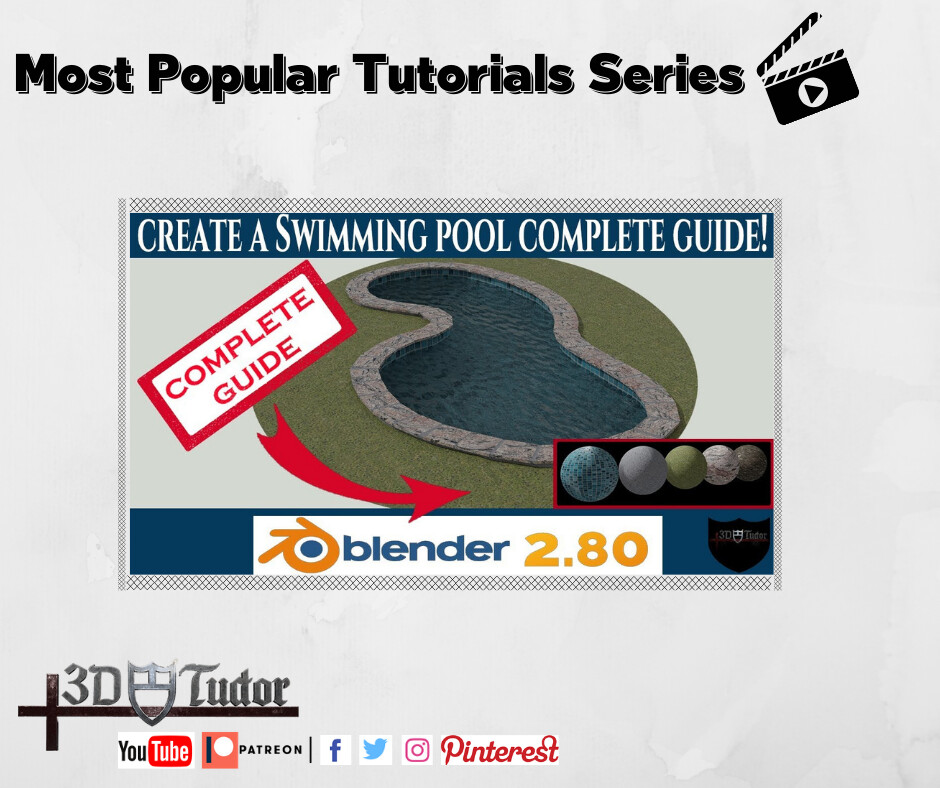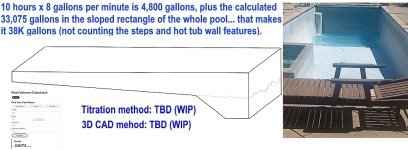There is also a
Chemical Way of Calculating Pool Volume using an alkalinity test kit, sodium bicarbonate or acid, and the formula.
Thanks for that wonderfully easy-to-perform alkalinity + acid/base-titration volume-calculation method, which I will definitely use as I need to add immense amounts of acid anyway as
I'm refilling my pool with very high alkalinity well water as we speak. Hence, I wouldn't want to add any sodium bicarbonate; but I will need quite a few cases of HASA 31.45% HCl (at $46.98/case taxed, or $11.75/gallon, taxed) anyway - so I will definitely run the suggested acid test to titrate the pool volume.
Multiply 125,000 (which is the formula number for Muriatic Acid) times the number of quarts of acid added, divided by the ppm reduction in alkalinity caused after circulating the water for a few hours (being extra careful to not add too much acid at one time - where - generally, it is safe to add four quarts of acid per 40,000 gallons of pool water when the TA is over 160 ppm and the pH is above 7.7. Four quarts of acid will lower the TA by 12.5 ppm per 40,000 gallons.
Even so, the whole point is to have a 3D CAD model of the pool, where I have already measured everything and calculated the volume but the point isn't so much to calculate the volume as to play with the CAD software - mostly for the sake of the beauty of learning how to use CAD software - which - is more fun when there is a specific end goal in mind.
BTW, I'm an aspy, so if I can calculate the volume down to the milliliter (aka cubic millimeter) - that would make me very happy before I die.
Now that we’ve give u all sortsa answers, why are you asking about this?
That's a good question where I think I wasn't clear that certainly
I can calculate the volume of a pool using basic arithmetic (as shown in the sequential attached images) but I want to learn how to use a CAD program with a real-world example - which - can then be easily honed such that all sorts of good things can happen when you learn how to design things yourself.
Suffice to say, the intent of this thread is that a CAD-specific thread is something this forum should have (IMHO).
So the goal is more about using the CAD program to model the pool than about calculating the volume of that pool - where - the point of asking here is I can't be the first person on this forum who wants to use a CAD program to model their pool. Right?
Looking up common free CAD programs, these are those that I found so far (for Windows) that I've downloaded and will see which ones are worth testing for laying out a pool (where others can also make use of my findings).
Of the dozen Windows CAD programs above, I think I'll try out Blender and/or Inkscape with Fusion360 first - based on the results of my Google searches. But the whole point of asking this question in this thread is to get a head start on which 3D free CAD program most of you prefer to use to model your pool.
The main advantages, as I see it so far anyway (which is why I'm asking here for advice from those who have done it) are:
- Blender - very well supported free cross-platform CAD with many tutorials (including for pools)
- InkScape - also very well supported - but specifically it supposedly does 2d to 3d photometry from a JPEG image
- Fusion360 - where, supposedly, InkScape converts 2D JPEG images into 2D SVGs which imports to Fusion360
If nothing else, this thread can serve as a useful reference for others - which is why I'm laboriously adding all the detailed links.
The advantage, if this thread is productive, to the group at large might be:
- Pool owners can easily model their pool in Blender freeware on any platform
- Pool owners can convert a flat 2D JPEG image of their pool with InkScape to a Fusion360 3D model
If we accomplish that, this thread will have been worth the effort the team expended on fleshing it out.

 blenderartists.org
blenderartists.org














